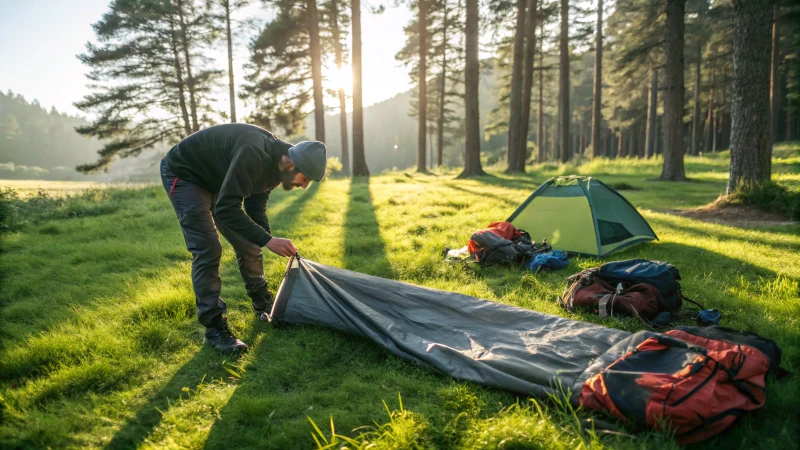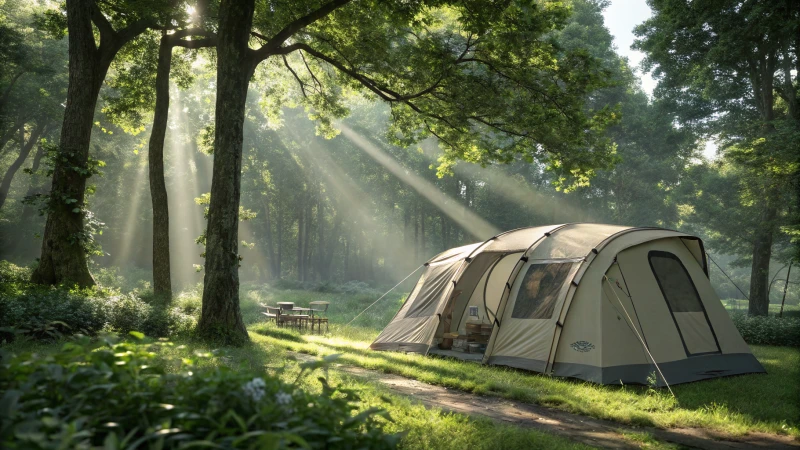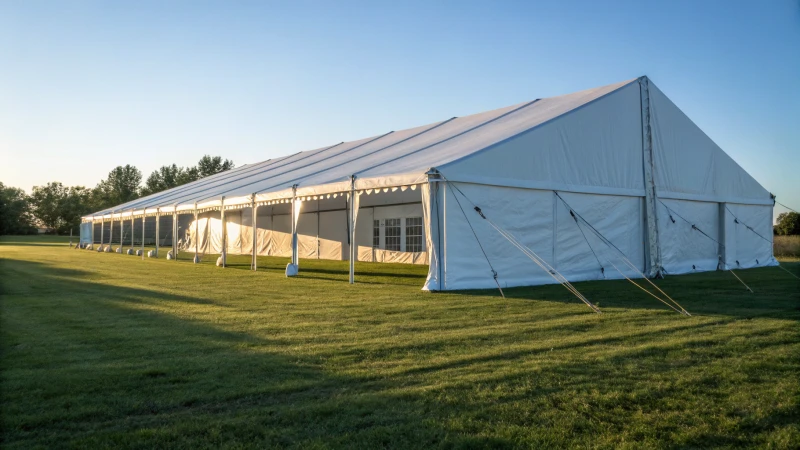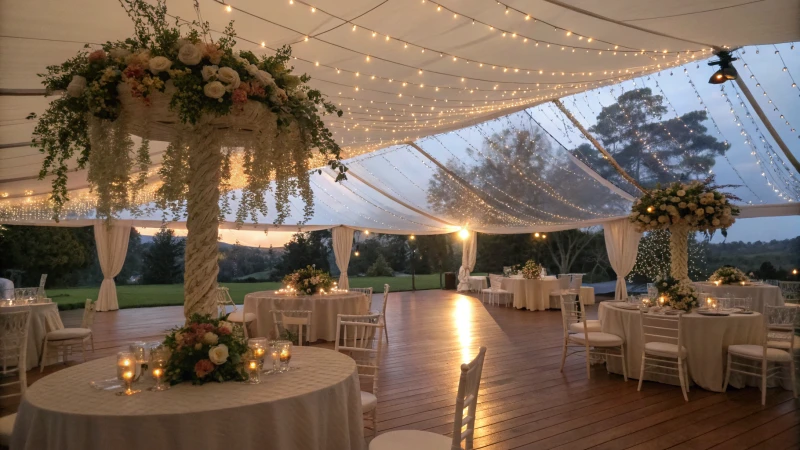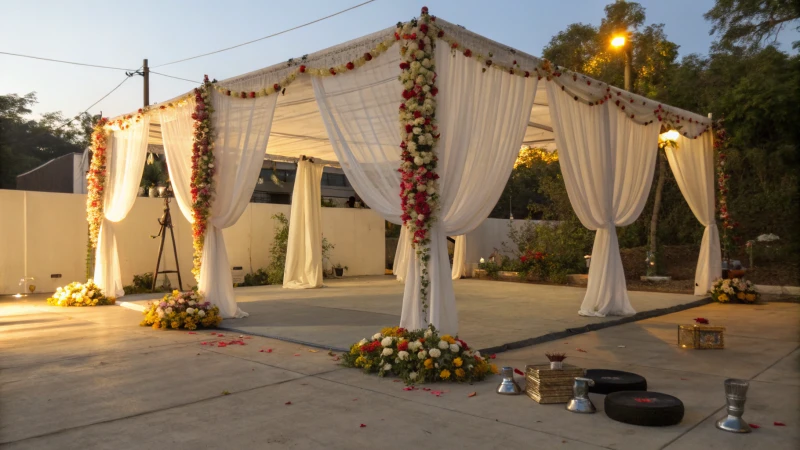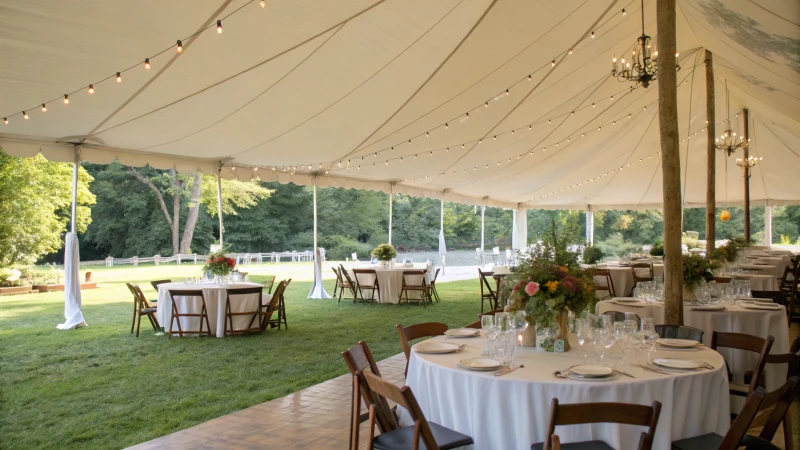
Ever hosted a massive gathering and felt the pressure of space planning? I have.
A 500-seater tent usually spans 5,000 to 6,000 square feet for banquet seating or 3,000 to 4,000 square feet for theater seating. The precise dimensions hinge on seating styles and extra features like stages or catering areas.
From my experience, it’s not just about numbers; it’s about the vibe you want to create. Every event has its own character and needs, whether it’s the intimate coziness of a wedding or the grand layout of a corporate gala. Choosing the right tent size is like setting the stage for memories—comfortably accommodating everyone and leaving room for magic moments.
A 500-seater tent needs exactly 5,500 square feet.False
Tent size varies between 5,000 to 6,000 sq ft for banquet seating.
Theater seating requires less space than banquet seating.True
Theater seating needs 3,000 to 4,000 sq ft, less than banquet style.
How Does Seating Arrangement Affect Tent Size?
Ever find yourself overwhelmed by the sheer number of details when planning an event? Picking the right tent size is one puzzle piece that can make or break your setup.
Seating arrangements play a crucial role in determining the tent size you need. Banquet seating requires more space per guest than theater-style. Plus, adding features like dance floors or stages increases the total square footage needed for a comfortable experience.
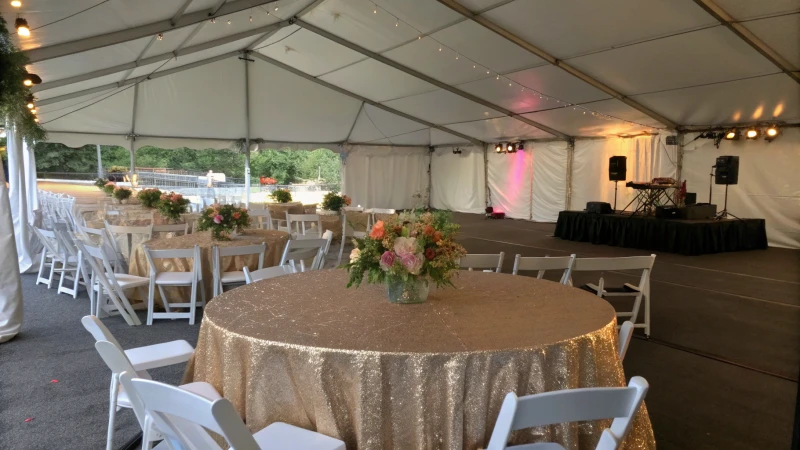
Analyzing Different Seating Styles
Banquet-Style Seating: I remember planning a friend’s wedding where we opted for banquet-style seating, with round tables for that intimate vibe. Each guest needed about 10-12 square feet, which meant for 500 guests, we had to book a tent that was 5,000 to 6,000 square feet. It was a lesson in spatial awareness!
| Number of Guests | Square Feet Needed |
|---|---|
| 500 | 5,000 – 6,000 |
Theater-Style Seating: On another occasion, I helped organize a corporate seminar. The theater-style seating was much more efficient space-wise, with each person requiring just 6-8 square feet. This time, our tent only needed to be 3,000 to 4,000 square feet for the same number of attendees.
| Number of Guests | Square Feet Needed |
|---|---|
| 500 | 3,000 – 4,000 |
Considering Additional Event Features
Beyond seating, think about extras like stages or dance floors. I once underestimated the space a stage required and had to scramble for a last-minute tent upgrade. Adding a stage can easily demand an extra 10% space1.
Balancing Comfort and Cost
Bigger isn’t always better, but it sure helps with comfort. When hosting events, ensuring enough room for guests to move around can elevate the experience. I’ve found using a tent size calculator2 invaluable in these scenarios.
Additional Tips for Tent Sizing
- Consider Aisles: More than once, I’ve seen events where cramped aisles led to traffic jams.
- Plan for Extras: Decorations and photo booths are fun additions but need space.
- Weather Contingencies: Don’t forget about heating or cooling—I’ve seen weather change plans drastically.
Keep these insights in mind as you plan your next big event, and you’ll find the perfect balance of comfort and cost in your tent sizing decisions.
Banquet seating needs more space than theater seating.True
Banquet-style requires 10-12 sq ft per person, theater needs 6-8 sq ft.
A stage requires no extra space in tent planning.False
Incorporating a stage typically adds about 10% more space to the layout.
What Extra Features Need More Tent Space?
Ever found yourself underestimating tent space at an event?
Features such as stages, dance floors, and catering areas demand extra tent space. These elements significantly alter the layout, so careful planning is crucial to ensure ample room for activities and comfort.
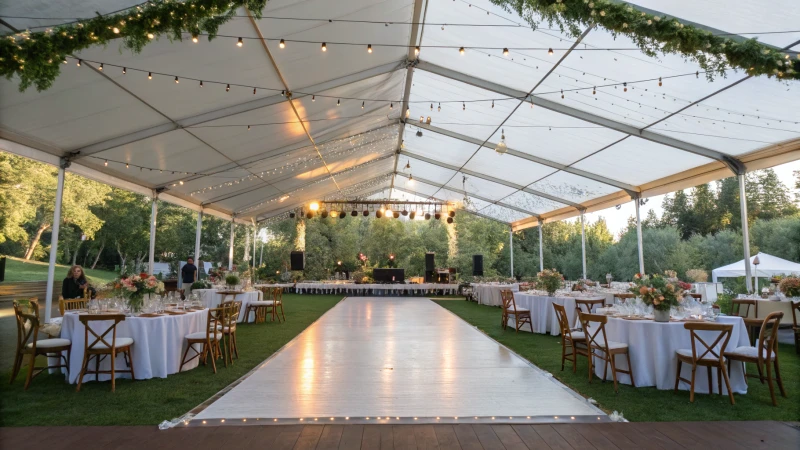
Stage and Entertainment Areas
I remember the time I organized a family reunion and decided to include a small stage for my cousin’s band. What started as a simple idea quickly transformed into a 200 square feet addition. It was a revelation—stages eat up space! Depending on your needs, be ready to allocate even more for larger performances. A small stage might need an extra 200 square feet, while larger setups may require3 significantly more.
Dance Floor
Ah, dancing! I’ve learned that if you want guests to let loose, you need around 5 square feet per person. For 100 dancers, that’s about 500 extra square feet. Different dance styles might tweak this a bit, but it’s a solid starting point based on dance styles4.
Catering and Food Service Areas
Food is love, right? Especially when you’re hosting an event. I usually add about 100-200 square feet per food station to keep the buffet lines smooth and guests happy. It might seem like a lot, but trust me, it pays off in smiles and full bellies.
| Feature | Space Requirement |
|---|---|
| Stage | 200-500 sq ft |
| Dance Floor | 5 sq ft/dancer |
| Catering Station | 100-200 sq ft |
Storage and Equipment
Never underestimate the power of storage space. Whether it’s AV equipment or extra chairs, having 50 to 200 square feet set aside can save the day. I’ve learned this the hard way—nothing beats being prepared!
Furniture and Decor
My favorite events are the ones with cozy lounge areas. If you’re going all out with sofas and tables, you might need an extra 200 square feet or more depending on the design. Lounge areas with sofas and tables might need5 additional space.
Weather Protection
Weather can be unpredictable. I always plan for heaters or fans to keep everyone comfortable, which means extra space for safety and smooth movement without obstructing guest movement or event activities6. It’s a small step that makes a big difference.
A stage requires 200-500 sq ft of tent space.True
Stages need significant space, varying by performance type and equipment.
Dance floors need 10 sq ft per dancer.False
Typically, dance floors require about 5 square feet per dancer.
How Do You Decide on the Best Tent Style?
Choosing the right tent style can feel like picking the perfect pair of shoes for a hike—it’s all about comfort, fit, and purpose.
To choose between tent styles, think about what you need for your camping adventure: roominess for comfort, material for sturdiness, and a design that’s easy to pitch. Each style—dome, tunnel, or cabin—has its own perks.

Understanding Tent Styles
When I first started camping, selecting a tent felt overwhelming. There were so many options! To make sense of it all, I began considering my camping environment7, the size of my group, and what I personally needed. Here are a few popular styles I explored:
-
Dome Tents: These are like the reliable friend who’s always ready for an adventure. With their semi-spherical shape, they’re great in windy conditions and super easy to set up. I loved how spacious they felt inside with minimal poles, making them light and easy to carry.
-
Tunnel Tents: Ideal for when you’re camping with family or friends. They offer tons of space and stability. Their elongated shape means you get plenty of room inside, though they do take a bit more effort to set up. It’s like setting up your own portable home.
-
Cabin Tents: If you’re in it for the long haul, these are perfect. They remind me of a cozy lodge with their vertical walls, giving you loads of headroom. Perfect for when you want to move in for a while, although they can be bulky and take some time to pitch.
Material and Weather Considerations
The material is key when it comes to weather resistance. I learned this the hard way on a particularly rainy trip! Nylon tents8 are light, perfect for backpacking, but if you’re worried about sun damage, polyester is the way to go.
Think about when you’ll be camping:
- 3-Season Tents: These are my go-to from spring through fall, offering a good balance between ventilation and protection.
- 4-Season Tents: These are built for harsher conditions. They’re sturdy and well-insulated but also heavier—great if you’re tackling winter camping.
Additional Features to Look For
Modern tents have all kinds of features that make life easier:
| Feature | Benefits |
|---|---|
| Vestibules | Extra storage space outside the main area |
| Multiple Doors | Improved access and ventilation |
| Built-in Awnings | Shade and rain protection |
I remember finding vestibules9 incredibly handy during wet trips—they kept our gear dry without cluttering the sleeping space.
Ease of Setup
For me, ease of setup is crucial, especially when camping solo. Some tents come with color-coded poles or clips that make assembly a breeze.
- Instant Tents: These can be set up in minutes—a lifesaver when you arrive at camp just before nightfall.
- Traditional Pole Tents: They offer durability but require more time and skill to set up.
Knowing your comfort level with these setups can help you decide if a quick setup tent10 is right for you.
Dome tents are ideal for wind resistance.True
Dome tents have a semi-spherical shape that offers excellent wind resistance.
Cabin tents are the lightest tent option available.False
Cabin tents are bulkier due to their vertical walls, not the lightest option.
Why Customize Your Tent Design?
Picture this: an event where your tent design isn’t just a shelter, but a statement that leaves guests talking long after they leave.
Customizing your tent design offers a multitude of benefits, including boosted brand visibility, tailored functionality, aesthetic enhancement, and superior protection. By catering to specific needs, it ensures your event stands out and runs smoothly.

Enhance Brand Visibility
One of the most exciting parts of customizing a tent is watching your brand come alive in the design. I remember attending a bustling trade show where my company’s tent, emblazoned with our vibrant logo11 and colors, caught everyone’s eye from across the venue. It wasn’t just a tent; it was a beacon that drew attendees right to us, transforming strangers into potential clients.
Tailored Functionality
Every event has its unique requirements, and custom tents can meet them all. Imagine needing separate sections for various activities or an elevated stage for performances. I once organized a concert where the customized tent allowed for a seamless blend of function and flair—each compartment was perfectly tailored to our needs, making every moment flow without a hitch.
Table: Customization Options
| Feature | Benefit |
|---|---|
| Stages | Elevated platforms for performances |
| Compartments | Separate areas for varied activities |
| Weather-proofing | Enhanced protection against elements |
Aesthetic Appeal
A beautiful tent can set the tone for an unforgettable event. For my sister’s wedding, we chose an exquisite custom tent with elegant drapery12 and soft lighting that turned the venue into a fairy-tale setting. Everyone commented on how magical it felt—proof that aesthetics matter more than you might think.
Superior Protection
Weather can be unpredictable, but with the right materials, your event can go on smoothly regardless. Choosing flame-retardant fabrics not only keeps everyone safe but also meets regulations, offering peace of mind in case of large gatherings.
Fact: Using flame-retardant materials can provide peace of mind and meet safety regulations during large gatherings.
Cost-Effectiveness in the Long Run
While investing in a custom tent might seem costly upfront, its durability and versatility save money over time. I’ve compared costs myself and found that reusing our custom-designed tents across different events significantly cut down on rental fees for additional equipment.
Consider exploring cost comparisons13 between standard rentals and custom designs to understand long-term savings.
By customizing your tent design, you’re not just creating a shelter—you’re crafting an experience that sticks with people. Evaluate each event’s unique needs to maximize these remarkable benefits and ensure every occasion leaves its mark.
Custom tents enhance brand visibility at events.True
Custom tents with logos and colors increase brand recognition among attendees.
Standard tents offer superior protection than custom ones.False
Custom tents allow for material choice based on weather, offering better protection.
Conclusion
A 500-seater tent typically requires 5,000-6,000 square feet for banquet seating or 3,000-4,000 square feet for theater seating, depending on additional features and comfort needs.
-
Understand the additional space requirements for including a stage in your event tent. ↩
-
Explore calculators to accurately determine the right tent size based on your event specifics. ↩
-
Understanding stage size requirements helps ensure ample space for performers and equipment. ↩
-
Learn about different dance floor sizes to accommodate various dance styles comfortably. ↩
-
Explore how much additional space is necessary for elaborate furniture arrangements. ↩
-
Discover strategies for integrating heaters or fans without disrupting event flow. ↩
-
Explore different camping environments to understand which tent style suits your adventure. ↩
-
Compare nylon and polyester materials to choose the best option for durability and weather resistance. ↩
-
Learn why vestibules might be an essential feature for storing gear outside your tent. ↩
-
Discover the benefits of tents designed for rapid assembly to save time and effort. ↩
-
Explore how branding at trade shows boosts visibility and attracts potential customers. ↩
-
Discover elegant drapery and lighting ideas to transform wedding tents. ↩
-
Learn about long-term savings with custom tent designs over standard rentals. ↩



